Third Floor

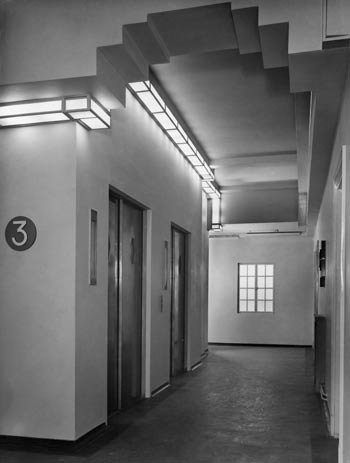
The short corridor running west-east, with the lifts which served the entrance hall. The Director-General's office was on the right of this photo, the Controller's office was behind the camera and the Chairman's just round the far corner.
The floor indicators were on shallow boxes which could be opened to reveal a list of offices and occupants on that floor.

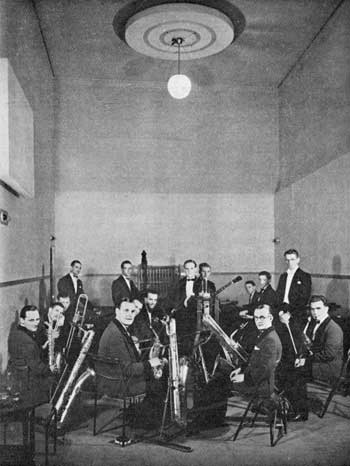
Designed by Serge Chermayeff, 3A was used for the Children's Hour and also for chamber music and dance band performances. The studio had a temporary decorative finish pending acoustical experiments.
The photo, below, shows the Silence Room the window of which is the one to the left of the door.
Up on the fourth floor, the Listening Room contained a mixer to handle the single microphone and the two gramophone points.
3A was 35' x 15' x 19' high, a volume of approximately 10,000 cubic feet. The reverberation time was 0.6 seconds.
below right - Henry Hall and the BBC Dance Orchestra pose in 3A.
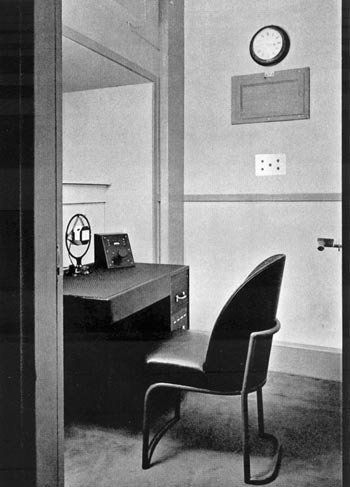
Studio 3B

The microphone seen on the table is a Marconi-Reisz Carbon.
The 1933 BBC Year Book commented on Chermayeff's talks studios: "The colours are all low in tone and harmonise. The lights are shaded, the furniture is comfortable with a comfort which one feels is produced by a profound study of anatomy. The rooms seem to induce bodily well-being and mental alertness. Here one feels is a setting in which lean-faced scientists can discuss relativity, or the more intellectual members of the Communist party an ideal distribution of wealth. One cannot, however, imagine oneself making love in them or playing with
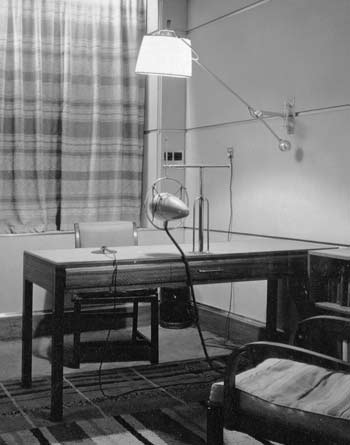
Visitors to Broadcasting House were always interested in 3B because it was the studio used by the Prince of Wales (later Edward VIII) when he broadcast (below). The microphone at this time was a Western Electric/STC 'Bomb' Condenser, also seen right.
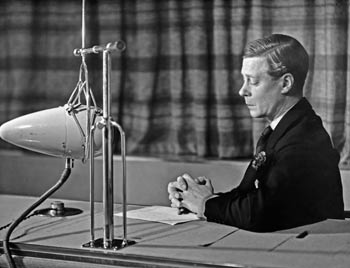
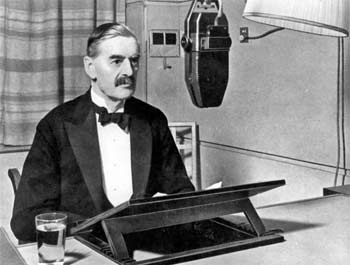
right - And, a little later, Neville Chamberlain broadcasts from 3B. By this time the microphone is a Type A.
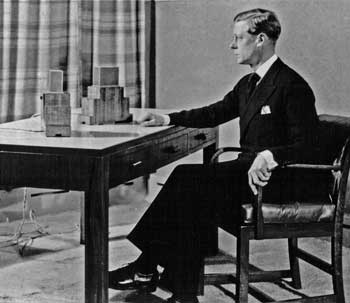
left - On the 1st March 1936 Edward VIII, a few weeks after becoming king, was back in 3B for a speech to the Empire. The studio has been re-arranged somewhat and the 'Royal' microphones are seen. These were actually the innards of Type A mics in specially made housings.
Related page
Studio 3C

3C was more austere than its
neighbours. In addition to its use as a studio it was also equipped as
a listening room. Talks auditions were listened to here.
Like 3B, it was 15' x 11' x 9', 1,500 cu. ft. but with a dead acoustic.
Like 3B, it was 15' x 11' x 9', 1,500 cu. ft. but with a dead acoustic.
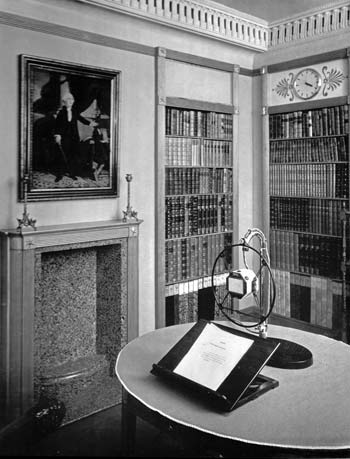
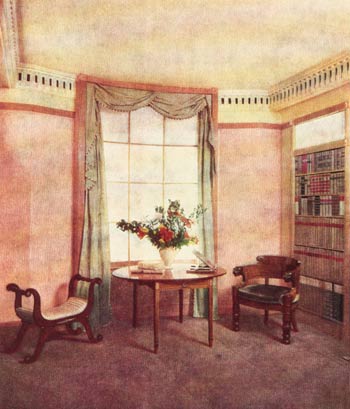
The 1933 Year Book again: "As a concession to the conservatism and weakness of human nature, it was decided by the authorities that one of the talks studios should be definitely traditional in flavour. It was feared that elderly dons and clergymen, so far from being stimulated and put at their best by the naked simplicitly of functionalism and metal furniture, would be definitely frightened of it. So a little library with every sham which could be crowded into so small a space was devised for their comfort. The pretty little room, designed by Mrs. Dorothy Warren Trotter, receives light from a large artificial window draped with curtains festooned in the true Regency style. The chief decoration of the walls is provided by book-cases filled with the loveliest book-backs gummed on to the plaster. There is a mantelpiece marbled to look like verde antico, but no fire can burn in it as it is not provided with a chimney. Over the mantelpiece a portrait of George Washington, the man who never told a lie, surveys the room with dignified hauteur. It would be absurdly puritanical to quarrel with these innocent deceptions. The room fulfils the conditions imposed on the designer. It is 'cosy,' an epithet which could not possibly be applied to the other studios."
The bookcases were in unstained waxed mahogany enclosed by reeded pilasters, transomes and architrave. The mitre-blocks were relieved by bright brass stars. The detailing was also applied to the door, mantelpiece and skirtings. The curtains were of pale green silk. The Regency furniture consisted of two carved armchairs (one once owned by Arnold Bennett), a small lyre-shaped settee, an oval Pembroke table and a miniature secretaire.
Like 3B and 3C, 3D was 15' x 11' x 9' high. The reverberation time was 0.35 seconds.
Studio 3E
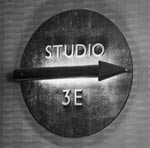
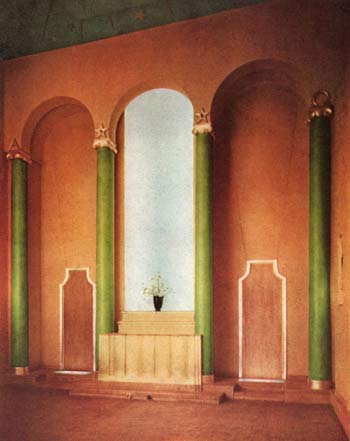
Like 3A the studio was double height, a small balcony being accessed from the fourth floor.
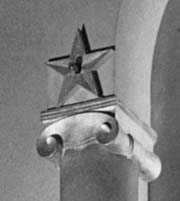
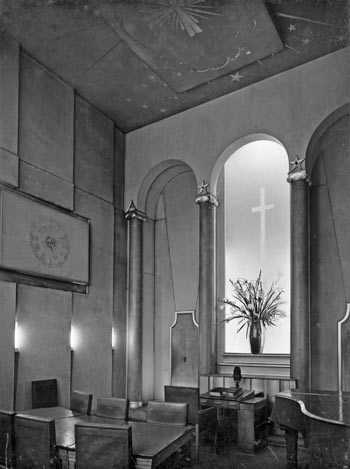
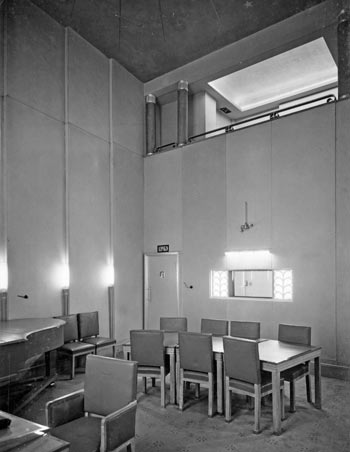
The walls were lined with pink
acoustical wall boards in four foot widths fixed vertically with four
inch breaks. In the breaks light fittings threw light towards the
'east' end.
During services a cross was projected onto the background above the altar.
The carpet was an Italian pink Wilton with a pattern of buffs and greens.
The clock, with hands and figures of gold and silver gilt, was mounted on a panel which concealed a ventilation intake.
The ceiling was blue, spangled with gold stars and crescent moons. A backlit recess above the balcony ceiling created the illusion of sky.
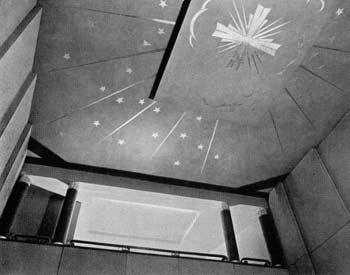
The furniture was grey-pink limed oak with grey hide tops and steel edgings.
3E was 21' x 18' x 19' high, a volume of approximately 7,000 cubic feet. The reverberation time was 0.8 seconds.
below right - In a niche by the piano stood a statue of St. George by Vernon Hill (1887-1972).
During services a cross was projected onto the background above the altar.
The carpet was an Italian pink Wilton with a pattern of buffs and greens.
The clock, with hands and figures of gold and silver gilt, was mounted on a panel which concealed a ventilation intake.
The ceiling was blue, spangled with gold stars and crescent moons. A backlit recess above the balcony ceiling created the illusion of sky.

The furniture was grey-pink limed oak with grey hide tops and steel edgings.
3E was 21' x 18' x 19' high, a volume of approximately 7,000 cubic feet. The reverberation time was 0.8 seconds.
below right - In a niche by the piano stood a statue of St. George by Vernon Hill (1887-1972).
The BBC began broadcasting a daily
service at 10.15 A.M. from the Daventry transmitter on 2nd January 1928
and on all transmitters from December the following year. Listeners
actually preferred the services to come from a real church and All
Souls, just across the road from BH was first used on 19th June, 1932.
This was the beginning of an association between the BBC and the church
that continues today. The picture below shows the Epilogue being
broadcast in 1935.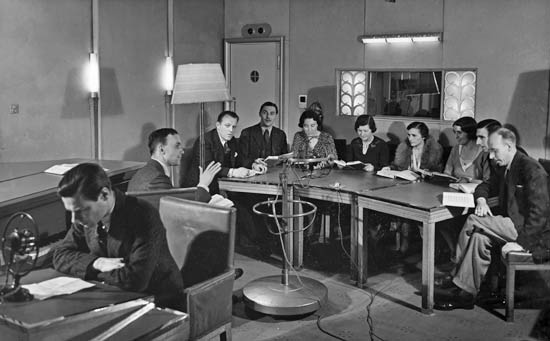 |
 |
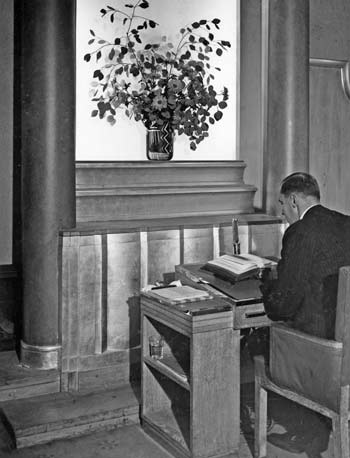
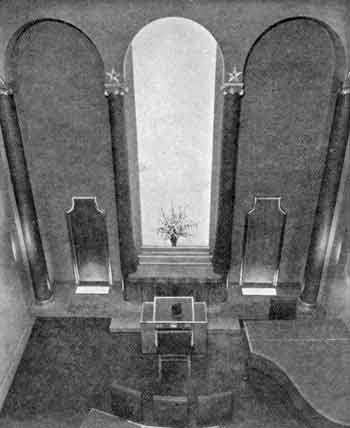
The view from the balcony, above, shows just how little space Maufe had to work with.
Commander A. B. Campbell was a regular broadcaster in the 1930s and in 'You Have Been Listening To...' he recalled a visit to 3E:
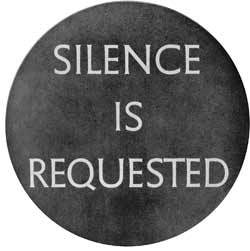
"This may appear strange, but when the BBC built this room ... it was suggested that it might be consecrated. However, when an official of the Church was approached, he visited the building and at once pointed out the impossibility of so doing. Any building to be consecrated must extend from the earth to the skies. There were several offices above this room, and below it more rooms and a cook's gallery. Though these served a very useful purpose, the consecration of them would be out of the question."
The Lounge
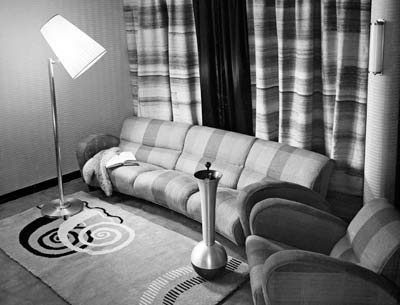
The Waiting Room Lounge was separated
from the corridor by heavy wool buff and grey curtains with stripes of
vermilion and blue. The carpet was by Marion Dorn. The curved settee
and easy chairs were upholstered in a coral-tweed type of fabric. The
vase-like object is an ash receptacle like the one described on the
eighth floor page.
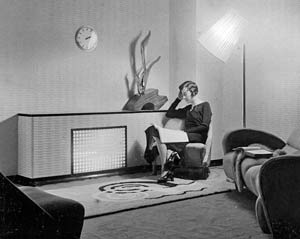
Commander A. B. Campbell again: "On each floor there is a foyer, where it is usual to sit and discuss the coming broadcast. These foyers are particularly attractive. The one on the third floor is replete with easy chairs, and an electric fire glows brightly in the wall. As a matter of fact, there is no heat in the fire, and ... it is merely an illusion to give a sense of comfort, for the whole B.B.C. building is kept at an even temperature and there are no fires."
Offices
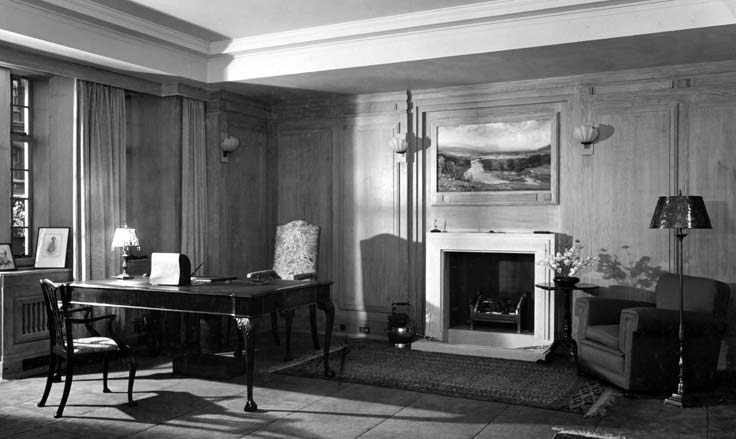
The Director-General's Office, above, like those of other senior officials, was panelled in light oak. The fireplace was rescued from Foley House, which had previously stood on the site of BH. Furniture was selected by the designers of the decoration of the studios.
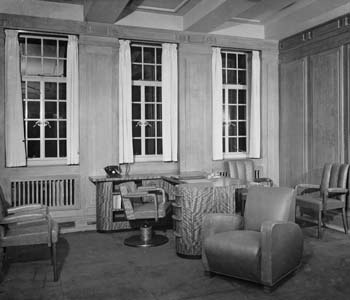
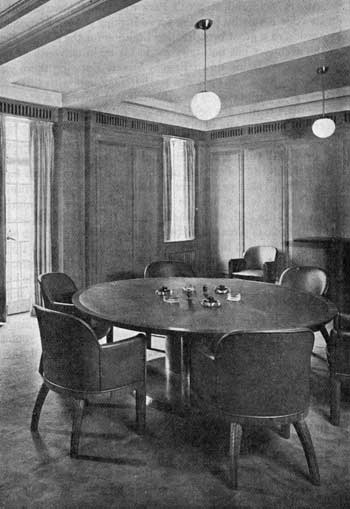
above - The Chairman's Office
below - The Controller's Office
right - The Boardroom
lower right - The Boardroom clock - preserved
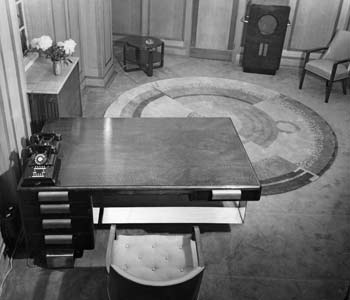

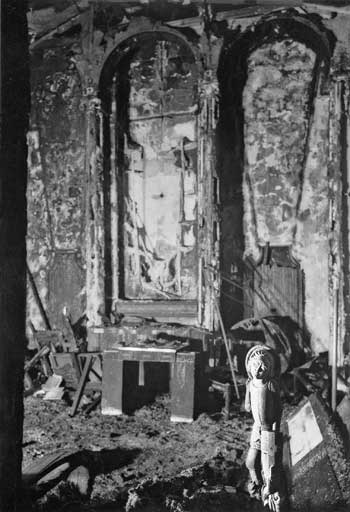
As mentioned on the fifth floor page, a German 500lb delayed action bomb hit the building on 15th October 1940. When it exploded, five floors of the tower were badly damaged.
On the the third floor the chapel studio, 3E, was wrecked (right), but Vernon Hill's statue of St. George appears to have survived unscathed.
3A collapsed under the weight of the floors above. The studio was being used by the Monitoring Service and four of their staff were among the seven who died as a result of the bomb.
Of all the third floor studios only 3B escaped serious damage.

